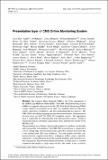| dc.contributor.author | Darlea, Georgiana-Lavinia | |
| dc.contributor.author | Demiragli, Zeynep | |
| dc.contributor.author | Gomez-Ceballos, Guillelmo | |
| dc.contributor.author | Paus, Christoph M. E. | |
| dc.date.accessioned | 2022-08-15T18:35:06Z | |
| dc.date.available | 2021-09-20T18:21:50Z | |
| dc.date.available | 2022-08-15T18:35:06Z | |
| dc.date.issued | 2018 | |
| dc.identifier.uri | https://hdl.handle.net/1721.1/132328.2 | |
| dc.description.abstract | <jats:p>The Compact Muon Solenoid (CMS) is one of the experiments at the CERN Large Hadron Collider (LHC). The CMS Online Monitoring system (OMS) is an upgrade and successor to the CMS Web-Based Monitoring (WBM)system, which is an essential tool for shift crew members, detector subsystem experts, operations coordinators, and those performing physics analyses. The CMS OMS is divided into aggregation and presentation layers. Communication between layers uses RESTful JSON:API compliant requests. The aggregation layer is responsible for collecting data from heterogeneous sources, storage of transformed and pre-calculated (aggregated) values and exposure of data via the RESTful API. The presentation layer displays detector information via a modern, user-friendly and customizable web interface. The CMS OMS user interface is composed of a set of cutting-edge software frameworks and tools to display non-event data to any authenticated CMS user worldwide. The web interface tree-like component structure comprises (top-down): workspaces, folders, pages, controllers and portlets. A clear hierarchy gives the required flexibility and control for content organization. Each bottom element instantiates a portlet and is a reusable component that displays a single aspect of data, like a table, a plot, an article, etc. Pages consist of multiple different portlets and can be customized at runtime by using a drag-and-drop technique. This is how a single page can easily include information from multiple online sources. Different pages give access to a summary of the current status of the experiment, as well as convenient access to historical data. This paper describes the CMS OMS architecture, core concepts and technologies of the presentation layer.</jats:p> | en_US |
| dc.language.iso | en | |
| dc.publisher | EDP Sciences | en_US |
| dc.relation.isversionof | 10.1051/EPJCONF/201921401044 | en_US |
| dc.rights | Creative Commons Attribution 4.0 International license | en_US |
| dc.rights.uri | https://creativecommons.org/licenses/by/4.0/ | en_US |
| dc.source | EPJ Web of Conferences | en_US |
| dc.title | Presentation layer of CMS Online Monitoring System | en_US |
| dc.type | Article | en_US |
| dc.contributor.department | Massachusetts Institute of Technology. Department of Physics | en_US |
| dc.relation.journal | EPJ Web of Conferences | en_US |
| dc.eprint.version | Final published version | en_US |
| dc.type.uri | http://purl.org/eprint/type/ConferencePaper | en_US |
| eprint.status | http://purl.org/eprint/status/NonPeerReviewed | en_US |
| dc.date.updated | 2020-11-05T16:59:49Z | |
| dspace.orderedauthors | André, J-M; Behrens, U; Branson, J; Brummer, P; Cittolin, S; Diego Da, SG; Georgiana-Lavinia, D; Deldicque, C; Demiragli, Z; Dobson, M; Doualot, N; Erhan, S; Fulcher, JR; Gigi, D; Gladki, M; Glege, F; Gomez-Ceballos, G; Hegeman, J; Holzner, A; Janulis, M; Lettrich, M; Mečionis, A; Meijers, F; Mommsen, RK; Morovic, S; O’Dell, V; Orsini, L; Papakrivopoulos, I; Paus, C; Petrova, P; Petrova, P; Petrucci, A; Pieri, M; Rabady, D; Rácz, A; Rapševičius, V; Reis, T; Sakulin, H; Schwick, C; Šimelevičius, D; Stankevičius, M; Cristina, VV; Wernet, C; Zejdl, P | en_US |
| dspace.date.submission | 2020-11-05T16:59:54Z | |
| mit.journal.volume | 214 | en_US |
| mit.license | PUBLISHER_CC | |
| mit.metadata.status | Publication Information Needed | en_US |
